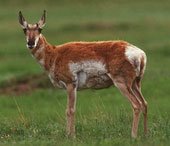Pronghorn Migration
 Humans Put Squeeze on Ancient Pronghorn Migration
Humans Put Squeeze on Ancient Pronghorn Migration by Nicholas Bakalar [article excerpt below]
Pronghorn—antelope like animals native to the United States—have followed the same migration routes through Wyoming's Greater Yellowstone region for more than 6,000 years. The animals' 100-mile (160-kilometer) seasonal journey is the longest land-mammal migration in the continental United States and is second only to the Arctic caribou's trek for long-distance migration in the Western Hemisphere.
But now the pronghorn's ancient routes between calving and wintering grounds are in danger from human development, and the future of Yellowstone's pronghorn herd is uncertain (pronghorn photo and profile).
Joel Berger, a senior scientist with the New York-based Wildlife Conservation Society, recently led a study of changes in the pronghorn's migration routes.
Using global positioning systems, Berger and colleagues tracked the movements of migrating pronghorn. They also estimated the maximum width of geographical bottlenecks along the animals' paths.
Their results, published in the latest issue of the journal Biology Letters, show that six of the eight historical pronghorn routes have vanished, and bottlenecks along the remaining routes have narrowed.
"The issue is critical," Berger said. "Any alteration in the bottlenecks through which pronghorn travel will only have serious negative effects and further squeeze the passage zones."
What's more, the scientists found that when the bottlenecks are blocked, the animals don't seek alternate routes—they just stop migrating.
Experts fear that if further development closes off these migration paths, it will interfere with the pronghorn's life cycle, eventually causing the species to disappear.
For more information:
Biology Letters
National Geographic
North American Pronghorn Foundation
Animal Diversity Web - Pronghorn factsheet
Yellowstone National Park
Photo credit: Raymond Gehman, NGS

0 Comments:
Post a Comment
<< Home